Interlaken - Entree to the Alpine Heart of the Bern Oberland
![]()
In the early 1800s, steamships began to ply the waters of the Thunersee and the Brienzersee, the Alpine lakes on either side of Interlaken. With onward railway connections to Zurich and Bern completed, travelers to Switzerland could easily reach this small village. Its awesome setting on an alluvial plain between the two lakes, surrounded by mountains with views of the great Alpine peaks, Eiger, Monck and Jungfrau, made Interlaken a place to relax and take in the vistas.
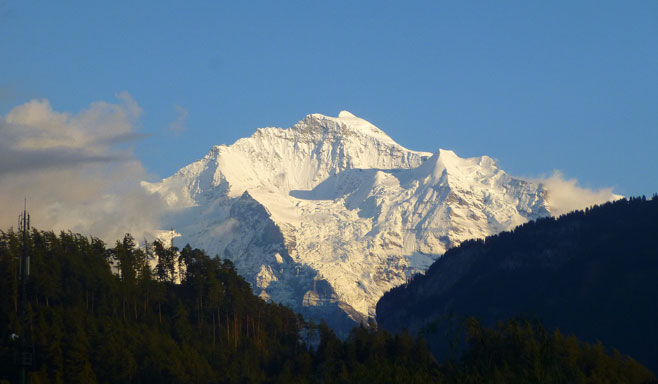
Before long, luxury hotels and spas were built to offer wealthy visitors the pampering they sought.
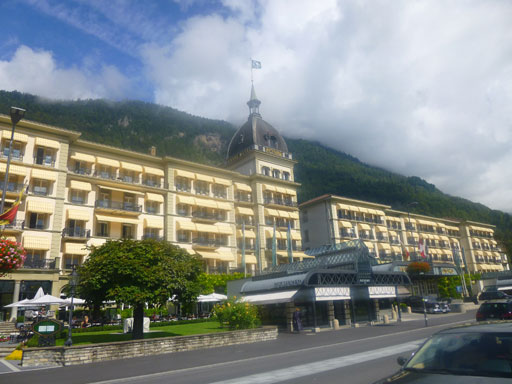
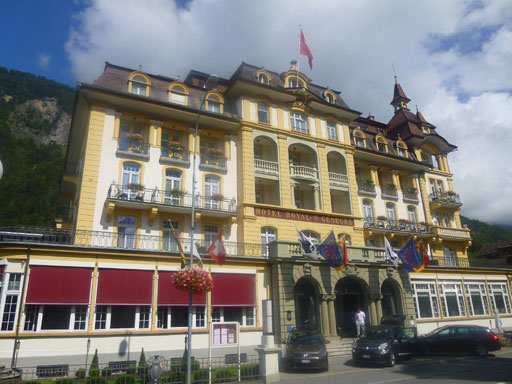
For those more adventurous folks, there were cable cars, funiculars, and cog railways to provide access to the surrounding landscape for skiing, mountaineering, hiking and other vigorous endeavors.
After a slow down of visitors during the time of the Great War and World War II, tourism began to expand in 1950 and Interlaken has not looked back! Today, Interlaken along with adjoining villages, Matten and Interseen, are home to 15,000 folks. We guess that most of the residents are connected to tourism in some way.
We decided to make Interlaken our base for exploring the Bernese Oberland, the heart of Switzerland's Alps. Each day, we ventured out to the Interlaken Ost station and by train from there, on into the surrounding mountains and countryside.
Lauterbrunnen
The Rough Guide (the travel guide we use) calls the Lauterbrunnen Valley "the most beautiful valley in Europe, bar none." To reach it, our train traveled south into this amazing valley with cliffs rising vertically on either side. Many waterfalls adorned the rock faces. The village (dorf) sits in a wider part of the valley with one main commercial street. We strolled along, enjoying the charming wooden sided buildings and the surrounding dramatic landscape. "The views are utterly spectacular" the Rough Guide states and we certainly can't dispute. We find that it is just not possible to describe how awesomely lovely this place really is! We offer our pictures below but must admit they don't come close to capturing the overall impact of the experience.
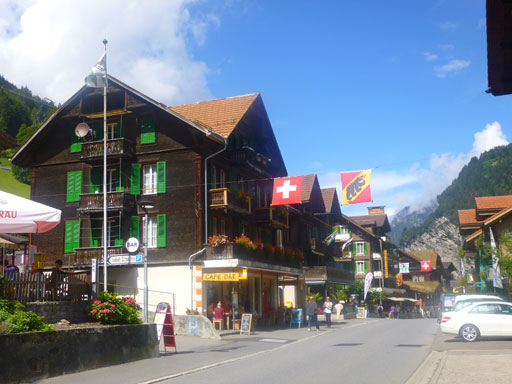
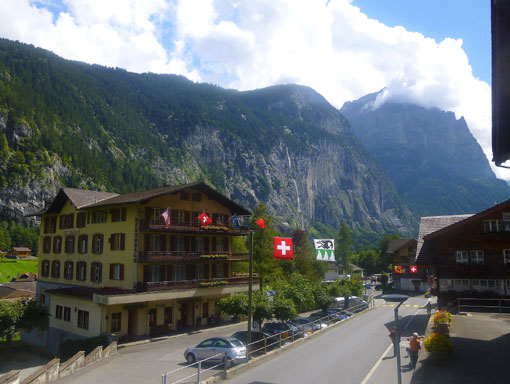
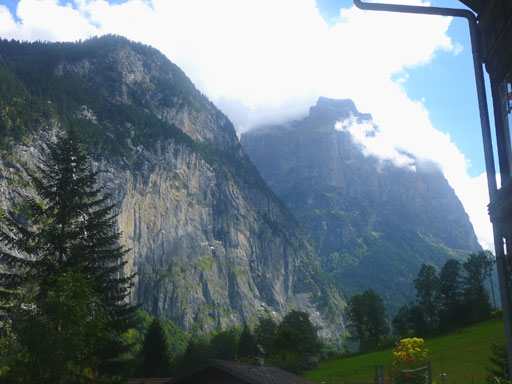
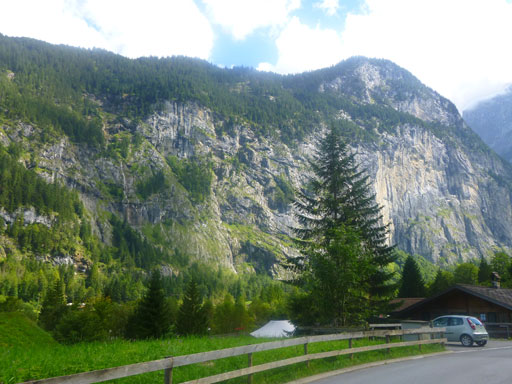
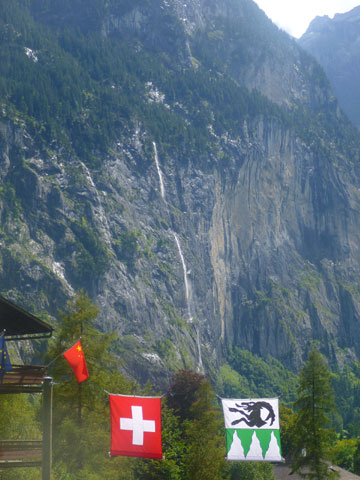
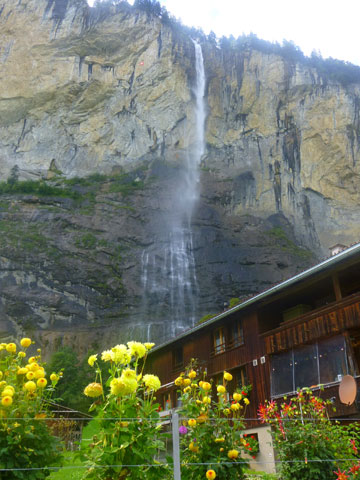
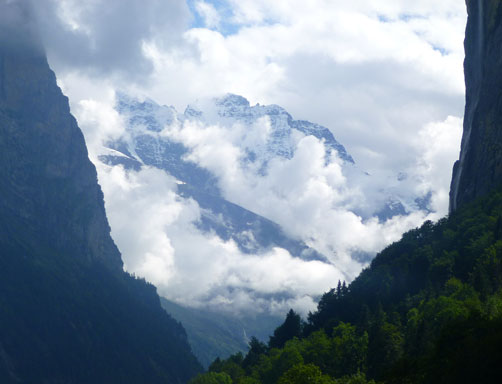
We continued our walk to the base of Staubbach Falls, at 300 meters, the highest waterfall in Switzerland, pouring a vast flow down from the heights above.
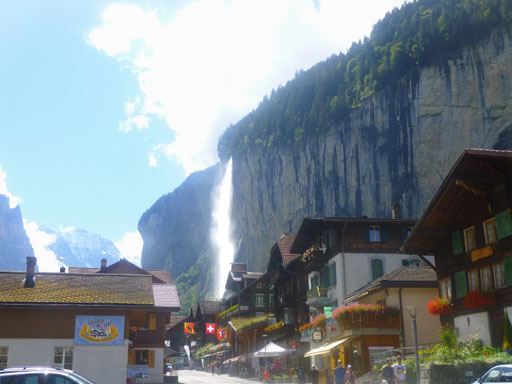
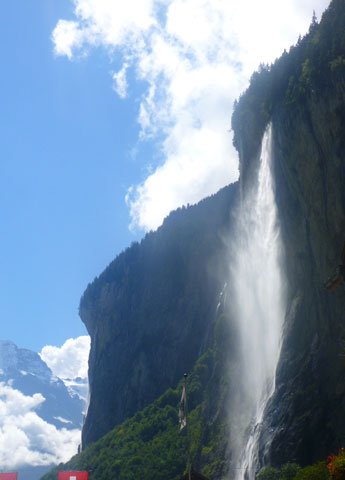

Returning, we passed the village cemetery, bright with flowers, and admired the homes along the way. What would it be like to live here, we wondered.
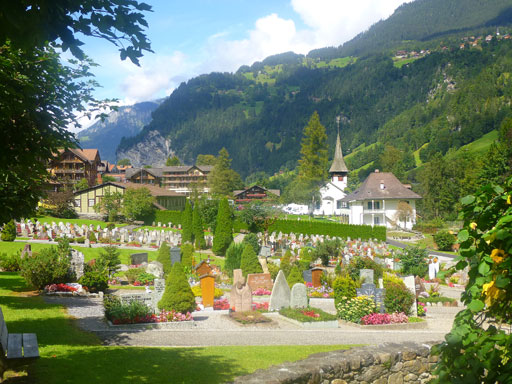
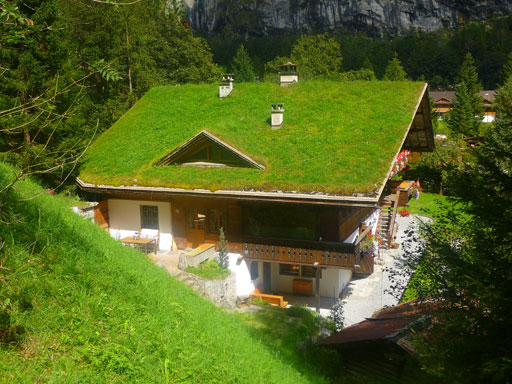
Returning to the station we rode the cog railway up to Wengen, a smaller village on a ledge 500+ meters above Lauterbrunnen (in upper right corner of the left picture above).
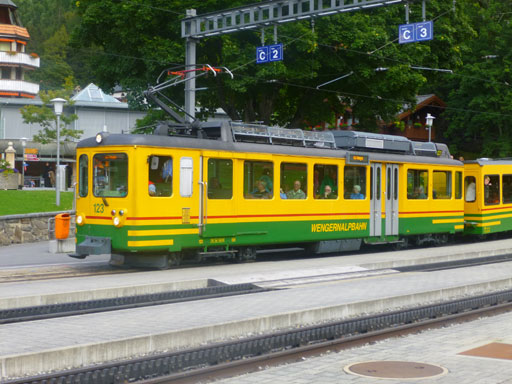
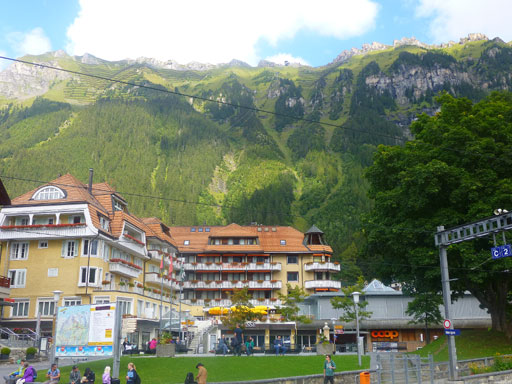
The views of the valley and the surrounding snowcapped mountains were even more spectacular from the higher elevation,
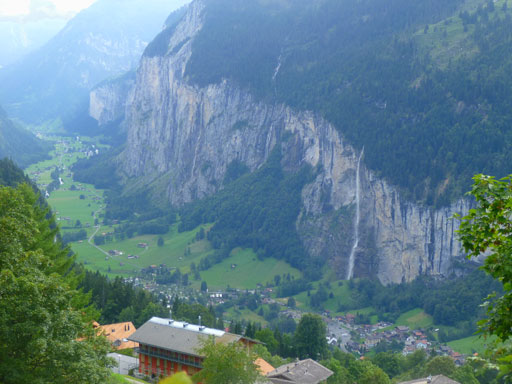

. . . and the vistas along the way, through the woods, past the vibrant green pastures and frequent waterfalls, were astounding!
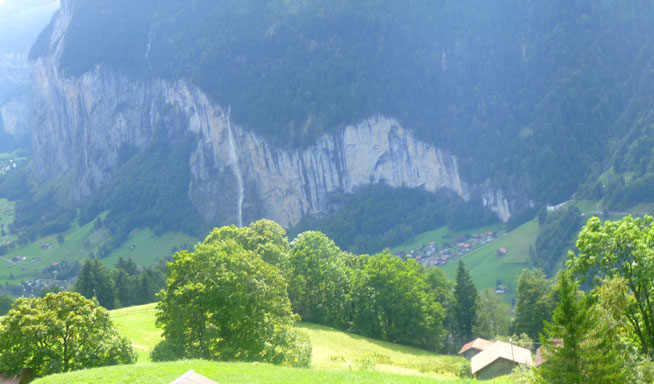
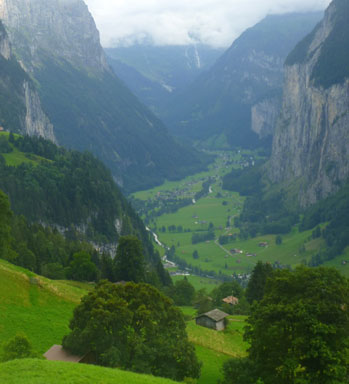
Now it was time for dinner. We picked a nice cafe and ate a yummy meal, including the typical Swiss rosti, made from shredded potatoes, nicely browned, and topped with fresh tomatoes and melted raclette cheese, nicely accompanied by Swiss wine.
Brienzersee and Thunersee
Ships began cruising on these lakes in the 1800s and this pleasant way to travel has stood the test of time! Initially steamships plied turquoise waters and now, although powered by diesel, some of the ships date back to the turn of the previous century.
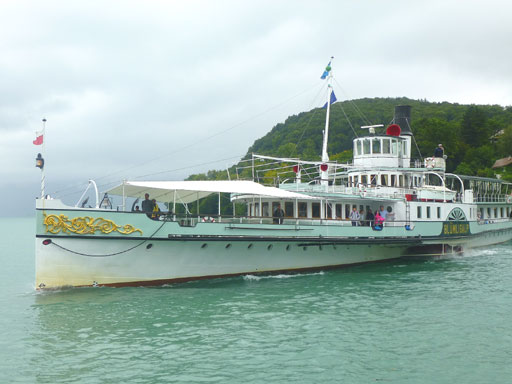
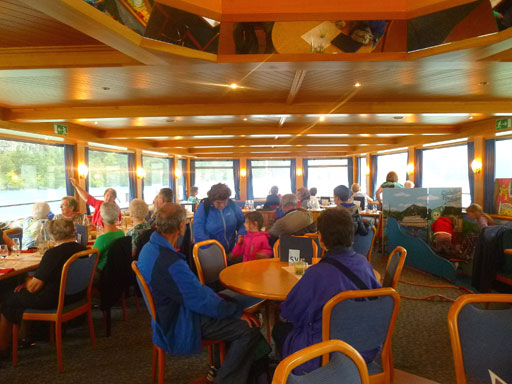
We cruised both lakes, taking in the panoramic views of the surrounding high slopes of dark green forests and bright green pastures, as well as the lake shore villages.
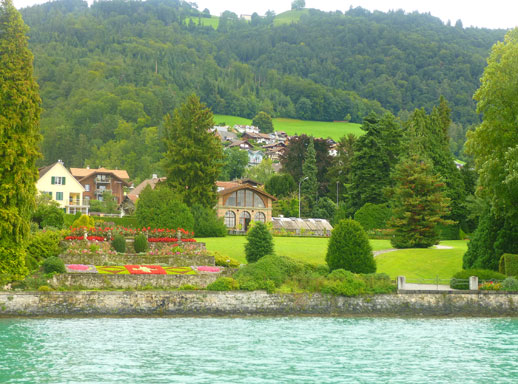
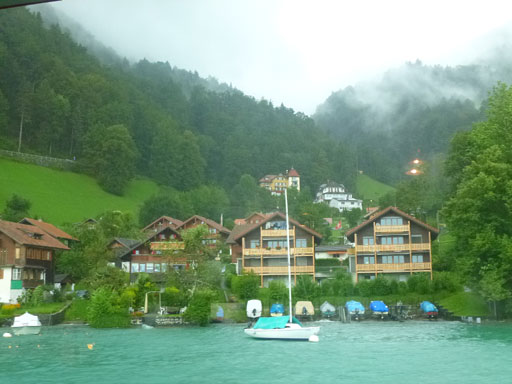
The village of Thun sits at the western end of the Thunersee, a nice place to hop off the ship to explore. Much less taken over by visitors, Thun is a peaceful place with historic architecture and a schloss up high on a hill behind the town. We considered staying here rather than Interlaken but it was less convenient for other excursions. Perhaps we'll return on another Swiss journey.
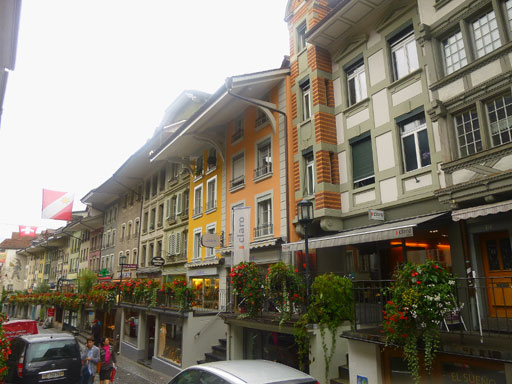
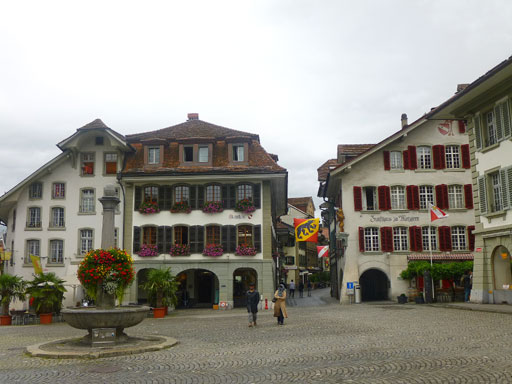
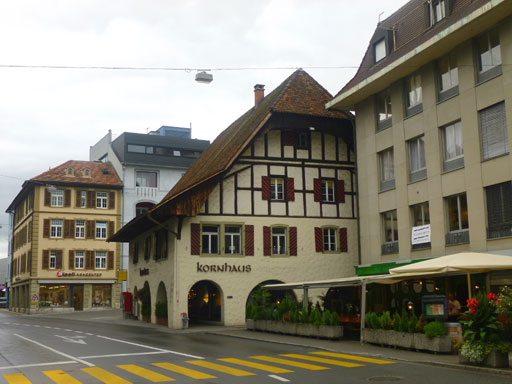
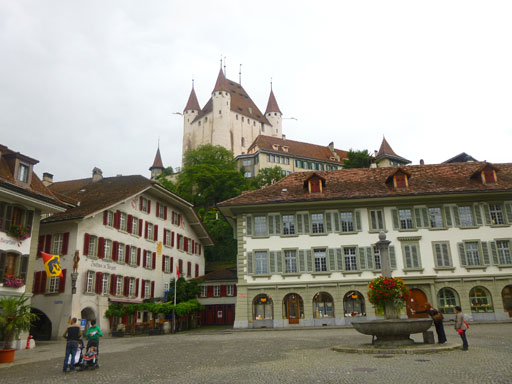
Brienz, at the eastern end of the Brienzersee is similarly peaceful and local. We reached it after a very pleasant cruise, again enjoying steep green hills and occasional waterfalls on both sides.
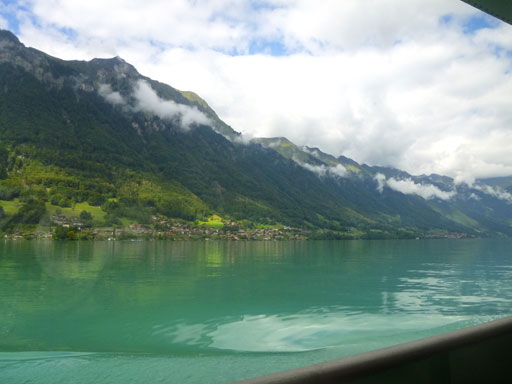
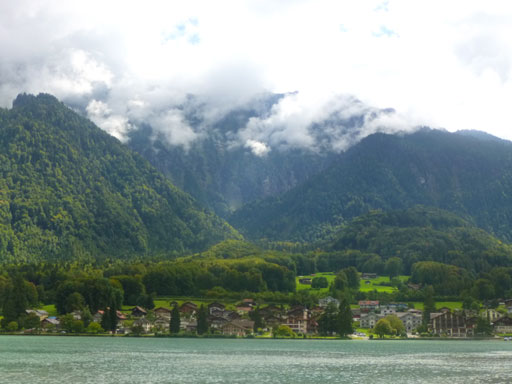
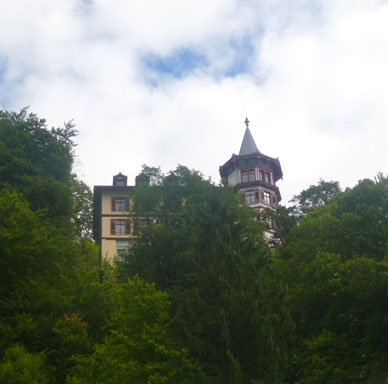
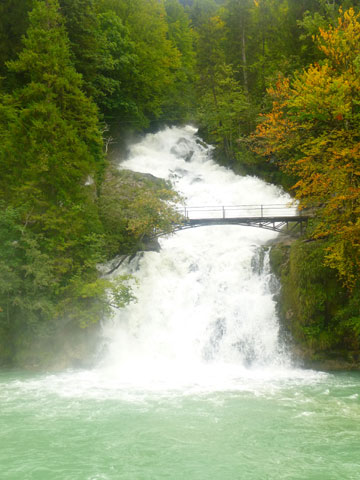
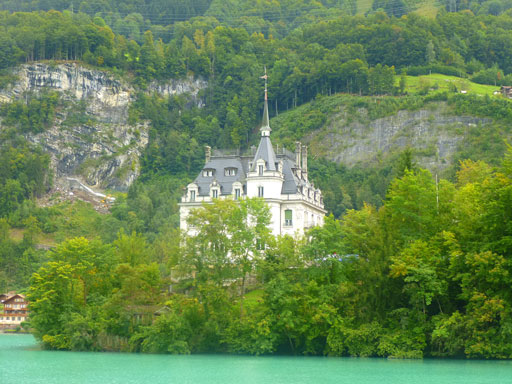
We waved good by to our ship and strolled along the main street and past a classic Swiss church. After stopping for lunch at a patisserie with great lake views, our walk took us along Brungasse, a small lane of dark wooden houses bright with flowers, oozing Swiss charm.

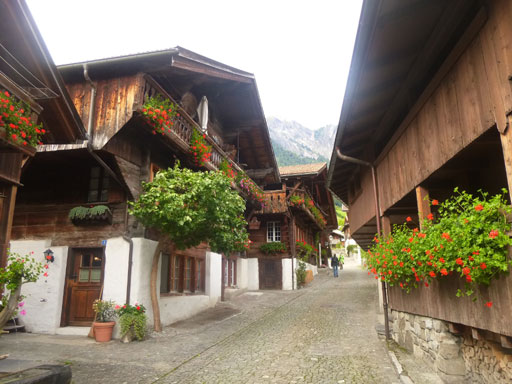
On the cliff above us, the waters of Giessbach Falls tumbled down to form a raging flow into the lake. Looking across the lake, we could see snowy peaks beyond the verdant forested slopes.
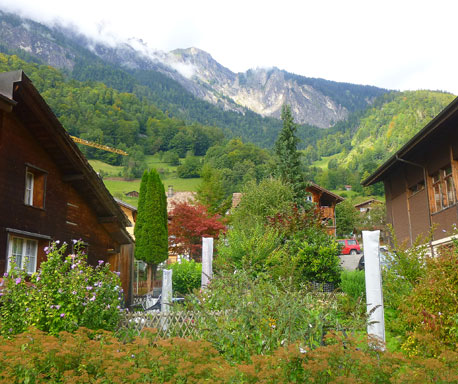
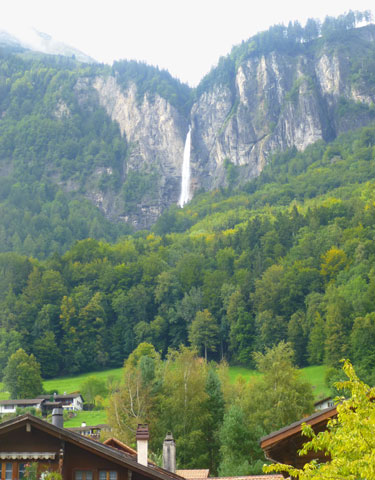
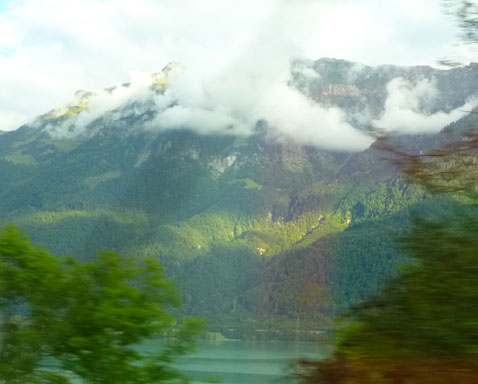
Meiringen and the mountain passes
The River Aare flows from the highlands above Brienz into the Brienzersee. Up river, the town of Meiringen offered a starting point for an amazing bus trip through the Aare watershed and over three passes to return to Meiringen. We set off by train to Meiringen, expecting to catch the bus at a stop near the station. We soon discovered that the whole town was full of sound! We had managed to pick the Sunday when groups from all over Switzerland had gathered to march and clang really large bells, Kuh Glocken, in unison. The sound was mesmerizing and cacophonous!
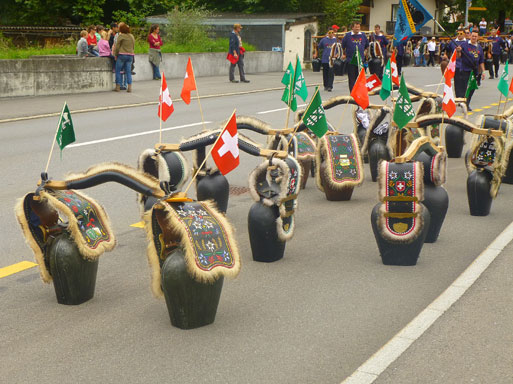
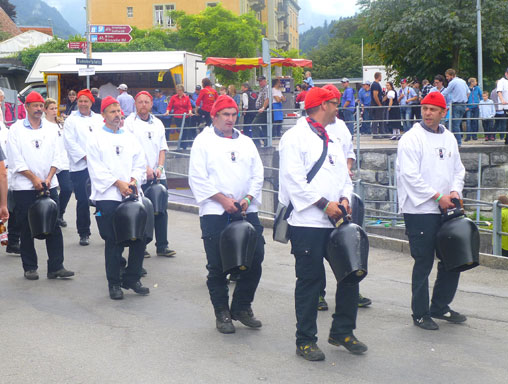
Before long, we realized that the streets were blocked off so buses would not arrive at the normal halt near the station. The Visitor Info person suggested we take a small train to a station just out of town, the new halt just for today. But we wanted to see more of the Kuh Glockeners! We walked through town, fascinated by all this clangorous tradition! Along the way we ate a snack of bread covered with a thick layer of raclette cheese (not exactly low calorie but really good!).
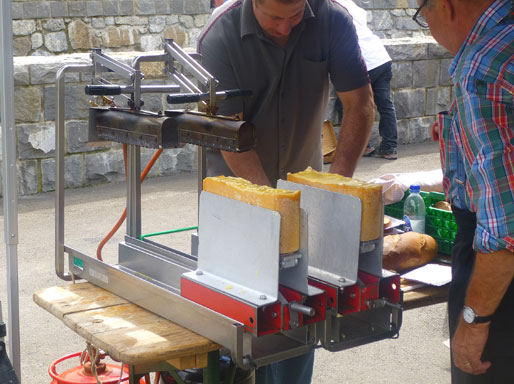
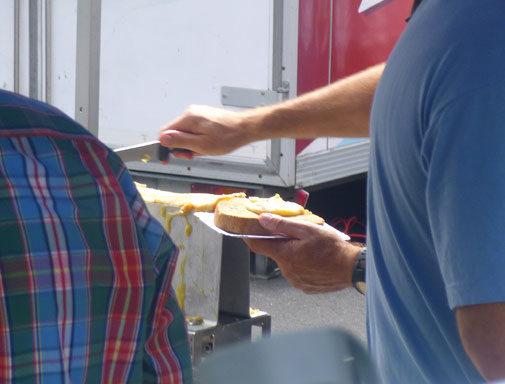
We asked folks about the bus stop and before long, the big yellow Post Bus arrived. We were the only passengers until we picked up another guy at the first stop, and a few more with their bikes a bit later.
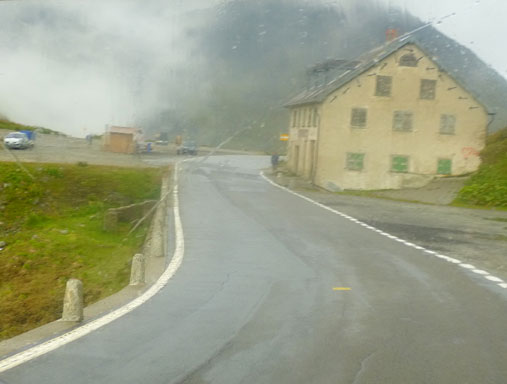
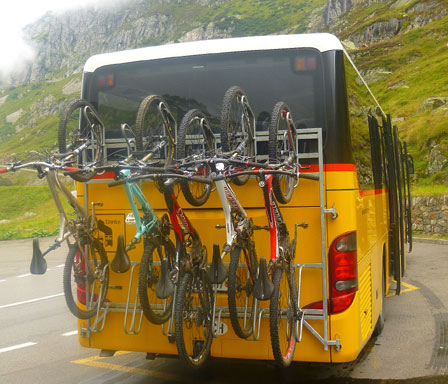
The road climbed up, with lots of switchbacks to the top of Susten Pass (2262 m) and then down into another watershed to Wassen with its landmark white church.
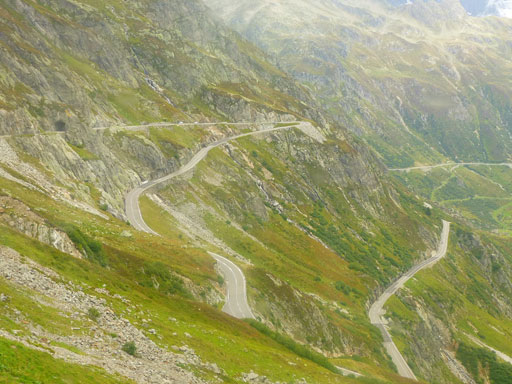
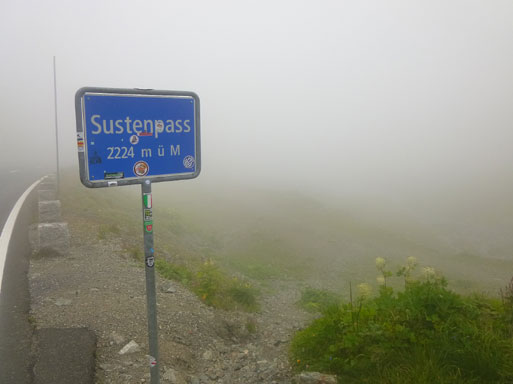
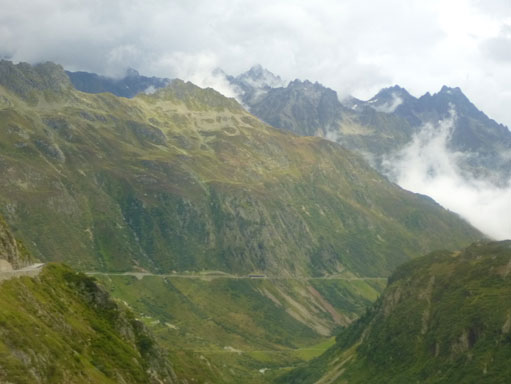
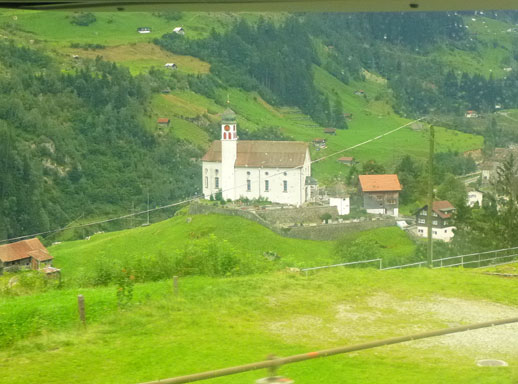
We continued on to Goschenen, the town squeezed into the narrow valley with the roads and railways leading to the rail and road entrances to the Gotthard Pass tunnels.
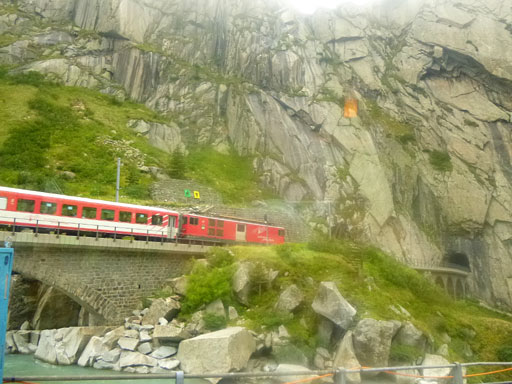
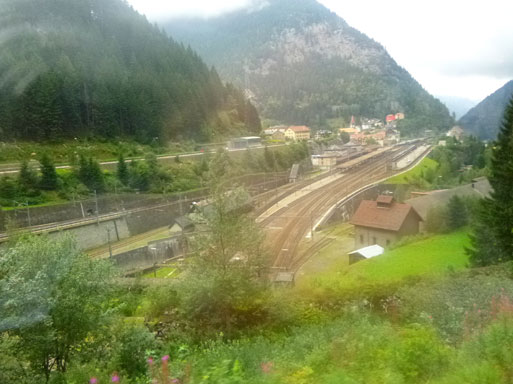
Inoring the deteriorating weather, our route now took us up over Gotthard pass and down into Andermatt. Continuing on, the bus climbed another switchback road, narrower and steeper than before, and into more rain and fog. In places the road traversed a narrow ledge with a drop off on one side and a rock wall on the other! Trust the driver, we thought! At the top, we crossed over Furka Pass (2436 m).
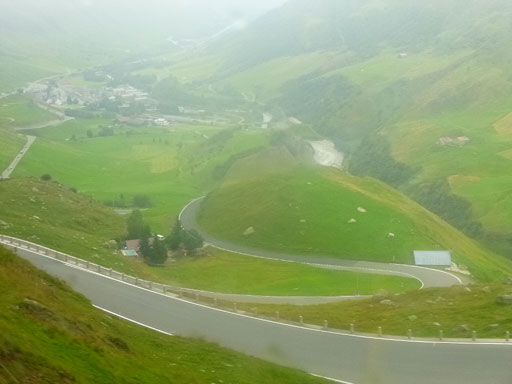
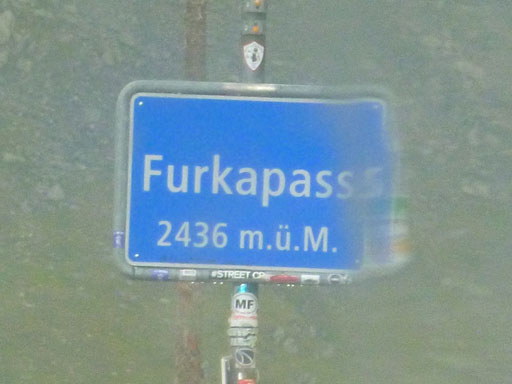
On the far side, the clouds had cleared and we enjoyed better views as we continued down to Gletsch, a small village that was once right at the tongue of the great Rhone Glacier, a major source of the River Rhone. Here, the Hotel Glacier du Rhone still welcomes visitors, but the ice is gone!
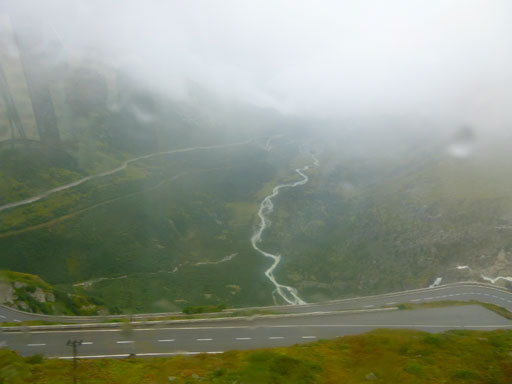
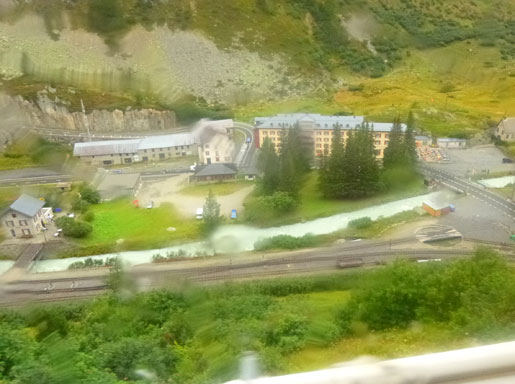
The bus stopped here and we had a 30 minute break, just enough time to visit this gracious hotel for apple cake and coffee.
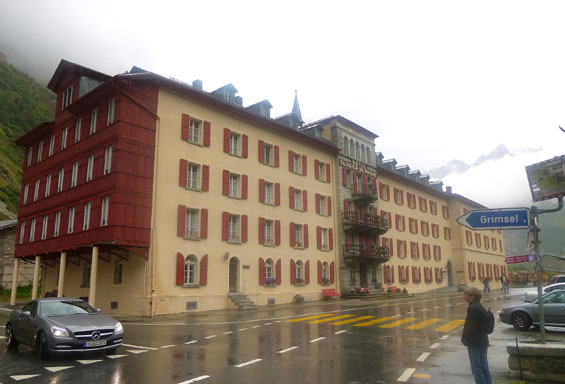
We waited for the next bus in the rain and continued the ride up to Grimsel Pass (2165 m) in total fog and rain, which unfortunately eliminated our ability to take pictures. The route makes small detours to several hydropower facilities and also passes various reservoirs that would have been interesting to see were it not for the fog.
We were just happy to be safely back in Meiringen where all was peaceful - the Kuh Glockeners had gone home. We caught the train back to Interlaken, marveling at the amazing journey we had!
Schilthorn Alp
There was one more journey we felt compelled to make - to Piz Gloria on the top of Schilthorn Alp. Returning to Lauterbrunnen, we rode a cable car up to Grutsalp, where we boarded a small train that took us on into Murren.
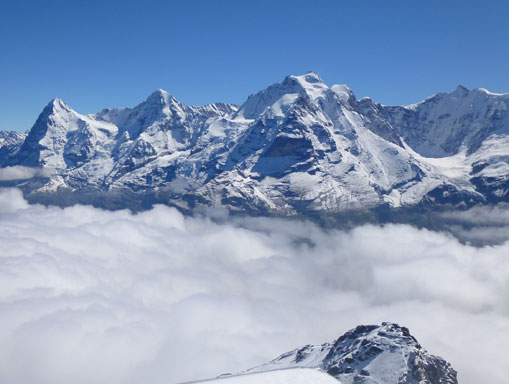
Another cable car rose up to Birg and into the clouds and snow. We transferred to yet another cable car to rise into the clouds and above them to Piz Gloria on Schilthorn Summit (2970 m). WOW! (picture at right)
Piz Gloria turned out to be an amazing three level building with a revolving restaurant, a shop (of course), large outdoor viewing terrace, and an exhibition, "Bond World 007", that explored the history of the James Bond phenomenon. Piz Gloria's existence was, in part, due to the making of the movie, On her Majesty's Secret Service in 1969, portions of which were filmed here.
From the moment we arrived, we realized that our viewing time would be limited. The clouds were building and rising so that before long all would be subsumed by the bright white fluff! We braved the cold on the terrace to marvel at the panorama of snowy peaks, sunlit, blue sky above, and the sea of fluff below! Soup in the cafe enabled us to revolve past the peaks. By the time we made a complete circuit, all of the peaks were submerged except the Big Guys, Eiger, Monck and Jungfrau!
The return journey entailed a ride down into the clouds to Birg, another ride down to Murren and a third to Gimmelwald. We strolled around this quaint small dorf, enchanted by the quintessential Swissness of the scenes! The final cable car took us down to Stechelberg on the valley floor where we felt a sense of relief at being back down to earth!
Click here to view our Flickr photo album of this trip
Reflection on this part of Switzerland
Our stay in Interlaken enabled us to experience the iconic places of Switzerland that the whole world knows. These experiences were definitely "on the list" of special places for us. Thinking back to those moments when we entered the Lauterbrunnen Valley, floated on the lovely lakes, traversed the alpine passes and stood atop the Schilthorn Alp, we feel the thrill all over again! We could easily return to do it all again - perhaps we will!
Click here to return to our 'Summer 2014 - Switzerland and More Time in Brussels' page
Click here to return to our 'Searching the World for People Friendly Cities' page
![]()